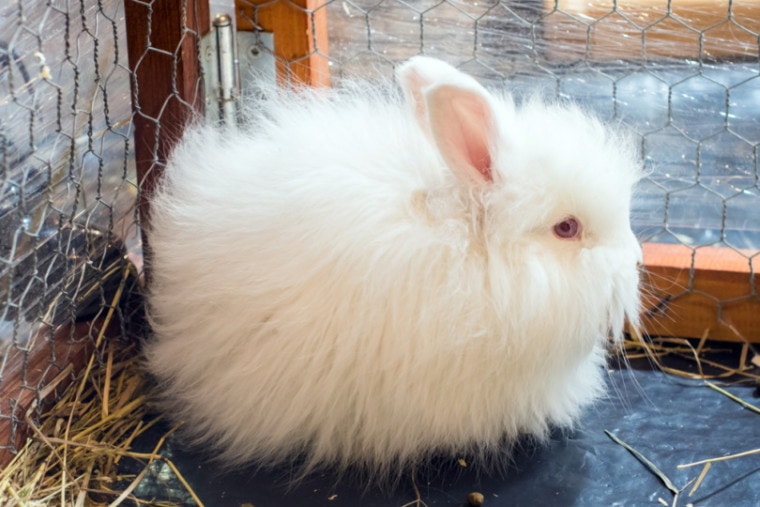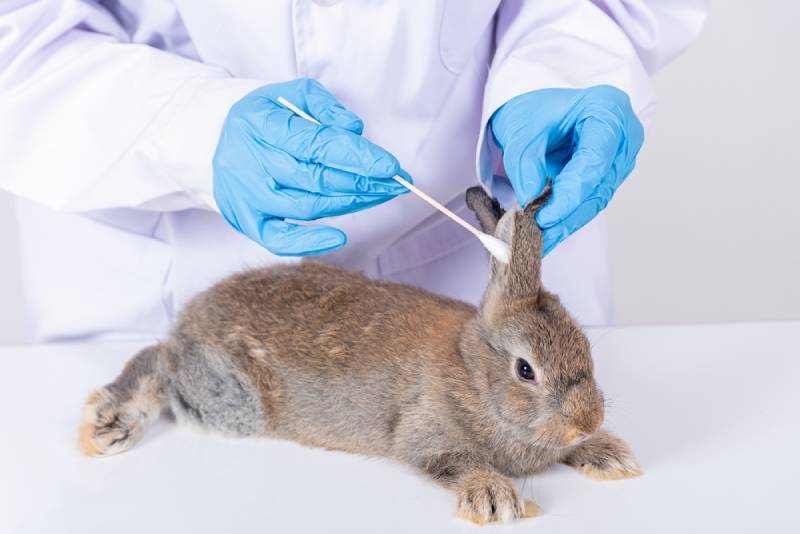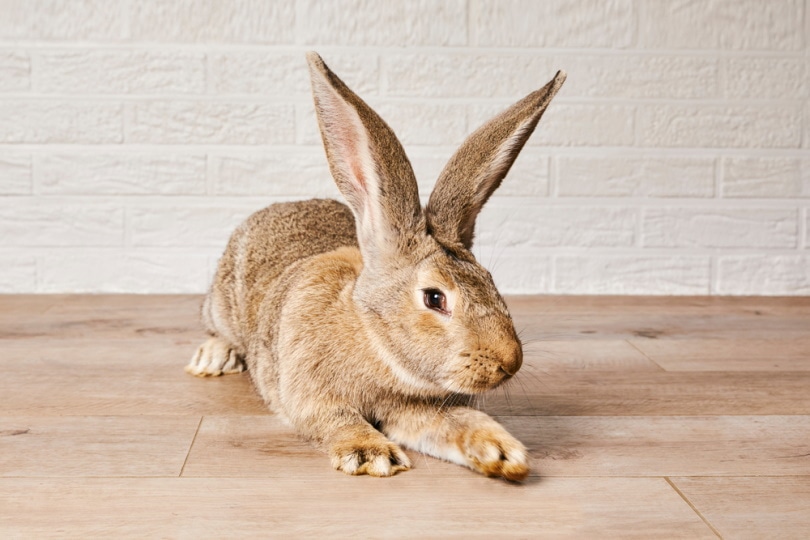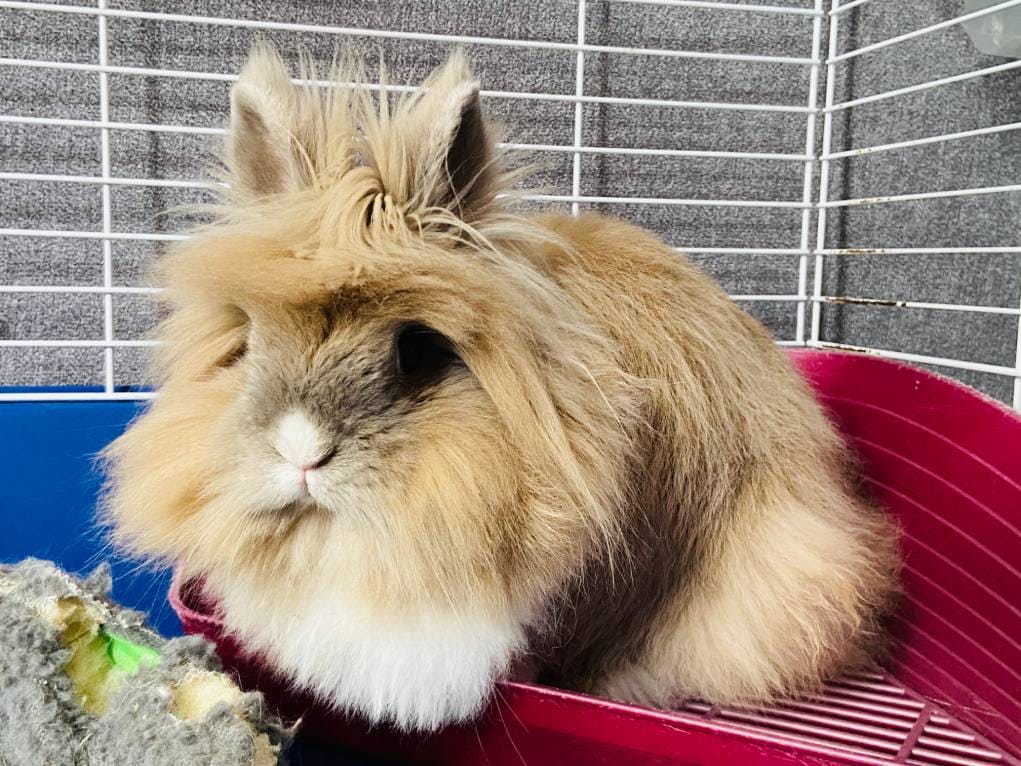
Click to Skip Ahead
The playful and adorable Satin Angora rabbit is known for its soft coat, appealing temperament, and maintainable size. They are medium-sized rabbits that are prized for their silk fur, which makes them stand out in comparison to many other rabbit breeds. Satin Angora rabbits require the same ongoing care as other rabbits, although their grooming needs might be more demanding.
Breed Overview
Size:
Medium
Weight:
6,5 – 9,5 pounds
Lifespan:
7–12 years
Similar Breeds:
French Angora, Satin Rabbit, Jersey Wooly
Suitable for:
Experienced rabbit owners
Temperament:
Playful, laidback, affectionate
The Satin Angora is one of the oldest domestic rabbit breeds, and they are a mix between the French Angora and the Satin rabbit. They were first developed around the 1930s by John C. Fehr but further developed by Leopoldina Meyer 50 years later.
The Angora rabbit originates from Ankara in Turkey, but the Satin fur on this rabbit was created in Ontario, Canada. The result of this breeding led to the creation of a soft-coated, shiny rabbit with the classic features of the popular Angora rabbit.
Satin Angora Rabbit Breed Characteristics
How Much Do These Rabbits Cost?
The price of a Satin Angora rabbit is typically high because they are not the most common type of Angora rabbit. Their shiny and soft coat makes them a top choice for rabbit shows, and farming to harvest their wool for product creation. Fortunately, the process used to harvest the Satin Angora’s wool does not harm them, and it can form part of their grooming routine.
Due to the Satin Angora rabbit’s rarity as a breed, you can expect to pay between $100 to $300 depending on where you get them from. Many breeders will sell these rabbits for a higher price because of their quality, while any Satin Angora rabbits in shelters or rescues will only cost the adoption fee.
Temperament & Intelligence of the Satin Angora Rabbit
Do These Rabbits Make Good Pets? 👪
Satin Angora rabbits can make excellent family pets, and they are social, affectionate, and typically easy to care for if you are an experienced rabbit owner. Like all pet rabbits, the Satin Angora rabbit requires proper care to stay healthy and live a long life of 7 to 12 years. Whether you are looking for a rare rabbit breed that quickly gets used to being handled, or you want a pet you can use for rabbit shows, the Satin Angora might be a breed worth looking into.
Does This Rabbit Get Along with Other Pets?
The Satin Angora is a social rabbit, so they enjoy getting attention and interaction from other pet rabbits. However, they should only be housed with other rabbits and other small pets. Dogs and cats can pose a risk to Satin Angora rabbits, which is why these two pets should be properly introduced and kept in separate areas of the home for safety.
Even if you can spend a lot of time with your Satin Angora rabbit, no amount of human interaction will make up for another rabbit companion. You should ideally house your Satin Angora rabbit with other peaceful, and compatible pet rabbits in a suitably sized enclosure. When you keep rabbits of the opposite sex together, one of them will need to be spayed or neutered by a veterinarian. Other breeds of rabbits can still reproduce together if they are compatible, so it is necessary to sterilize them regardless.
Things to Know When Owning a Satin Angora Rabbit:
Food & Diet Requirements 🥕
All rabbits, including the Satin Angora, are obligate herbivores. This means that they require a plant-based diet, with a large percentage consisting of hay and grasses. Their daily diet should ideally consist of high-quality hay and rabbit pellets, along with a portion of fresh vegetables. In comparison to other small pets, rabbits have more demanding dietary requirements that need to be met if you want your rabbit to remain healthy.
As much as 80% of your Satin Angora rabbits’ diet should consist of hay like timothy, alfalfa, oat, or orchard hay. These hays should be placed into a hay box where your Satin Angora rabbit can have constant access to hay. The pellets should make up a small percentage of their diet and be specifically formulated with high-quality ingredients for rabbits.
Habitat & Hutch Requirements 🏠
Your Satin Angora will spend the majority of its time in the enclosure, so be sure that it is suitably sized for the number of rabbits you keep. For the typical weight range of the Satin Angora, the cage should be around 24 by 36 inches, but the heavier your rabbit is, the larger the enclosure needs to be. Since rabbits should ideally be kept in pairs, you will need to increase this size to comfortably house both rabbits. If you keep your Satin Angora rabbit in an outdoor hutch, be sure to place the hutch so it offers your rabbit sufficient shelter from sun, rain, and wind.
Exercise & Sleeping Needs 🐇
Even if you exceed the minimum rabbit enclosure requirements, you should still offer your Satin Angora rabbit a safe and rabbit-proofed area to free roam. Rabbits are crepuscular animals, which means that they will spend the majority of their day sleeping while being most active during dawn and dusk.
This makes it easier for rabbit owners to find time during the day to exercise their rabbits before or after work, and an hour or two of the free room will be suitable for many rabbits. However, most rabbits will benefit from 3 hours of free roam and playtime during their active hours per day. The Satin Angora rabbit won’t be the best pet for you if your work and lifestyle don’t allow you to take your rabbit out of its cage every day.
Training🥎
Like other rabbits, the Satin Angora can be potty trained. This will be easier to do in sterilized (spayed or neutered) rabbits since they have a lower desire to mark their territory. You can start training your Satin Angora rabbit when they are 4 to 6 months old after they have been sterilized by a veterinarian, but unsterilized rabbits can be potty trained too.
Grooming ✂️
The Satin Angora rabbit’s coat is one of its most popular and distinctive features. They have a long and soft coat that has a silky sheen in the right lighting, so keeping up with a grooming routine will help their coat remain in good shape. They produce some of the finest and softest wool, and the wool can be harvested by shearing or plucking loose hairs.
If done properly in a calm environment with hygienic grooming tools, the whole harvesting process should not harm the rabbit or cause them unnecessary stress. However, if you only want to groom your Satin Angora rabbit while having no use for the wool, you can stick to regular brushing and nail trims.
You can brush your Satin Angora three to four times a week and trim their nails to prevent them from becoming overgrown. Brushing and plucking the loose and potentially matted hair from their coat can also help prevent your rabbit from ingesting it when they groom themselves.
Lifespan and Health Conditions 🏥
The Satin Angora rabbit has a standard lifespan of 7 to 12 years, much like many other rabbit breeds. However, factors such as illness and health conditions may shorten your rabbit’s lifespan. This makes it important to take your Satin Angora rabbit to an exotic veterinarian when they are feeling under the weather.
Part of the responsibility and commitment to owning a rabbit is to take them to a veterinarian when necessary since there are few things you can treat from home.
Male vs Female
Male and female Satin Angora rabbits look very similar, and there are few behavioral differences once they have been spayed or neutered. Many of the unwanted behaviors seen in male rabbits may be due to their hormones and getting them neutered by a veterinarian can help this problem. Overall, most male Satin Angora rabbits are laid-back and friendly, and they are often described as less independent than females. Female Satin Angora rabbits are just as friendly, and both sexes have their pros and cons.
However, if you do choose to get a Satin Angora rabbit, getting them spayed by a veterinarian can reduce their risk of developing reproductive cancers. This is a common cancer that affects unspayed female rabbits and can be prevented.
3 Little-Known Facts About Satin Angora Rabbits
1. One of the oldest rabbit breeds
The Angora is one of the oldest rabbit breeds, and the Satin part in their name describes the silky and shiny fur of a breed variation.
2. Fur can be used for wool
Satin Angora rabbits are often used as fiber animals and are sometimes bred for their wool production.
3. Their wool is often made into clothing
Most humane method to harvest Satin Angora rabbits’ wool does not hurt them, and the wool can be made into clothing.
Final Thoughts
With proper care, Satin Angora rabbits can make wonderful pets. Their shiny coats are guaranteed to impress many rabbit lovers, and when cared for properly, these rabbits can live for over a decade. While they do require more intense grooming in comparison to other rabbits, Satin Angora rabbits make up for it with their affectionate and playful personalities. A healthy diet with plenty of hay, a suitably sized enclosure, and regular exercise is going to ensure your Satin Angora rabbit is kept healthy and happy throughout their life.
Featured Image Credit: Zanna Pesnina, Shutterstock









